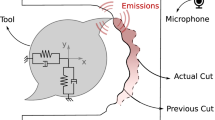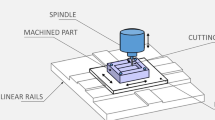Abstract
Machining chatter is a phenomenon resulting from self-oscillation between a machining tool and workpiece. This self-oscillation results in variation on the machined product that reduces the ability to meet desired specifications. Chatter is a widely studied topic as it directly relates to the quality of machined products. This study details the application of a Random Forest (RF) classifier with Recursive Feature Elimination (RFE) to machining audio collected by a single microphone during down-milling operations. This approach allows straightforward feature elimination that results in an easily understood set of analyzed dimensions. Stability is predicted solely based on the classification output of the RF classifier. Our approach proves highly predictive with consistent machining setup and a small sample set. We also review transferability between machining setups and present key findings. Our RF approach demonstrates the ability to analyze and classify chatter through a low-cost approach with limited training data required. The motivation for using a single microphone is to enable detection on machines without other sensors, such as accelerometers, present in the machining setup. The value of the in-process sensor and chatter classifier is highlighted because the machining setup included asymmetric dynamics that reduced the accuracy of the traditional analytical stability solution. We see a natural progression to deploying this audio-only methodology with real-time processing and classification using either a laptop or smartphone. This progression will allow visual indicators during the machining process that can alert machinists of progression into unstable machining processes.








Similar content being viewed by others
Data availability
Audio files and derived data are not publicly available.
Code availability
Code written in this study is not publicly available.
References
Taylor F (1906) On the art of cutting metals. Am Soc Mech Eng Proc Suppl 28(2):3–29
Tobias S, Fishwick W (1958) Theory of regenerative machine tool chatter. The Engineer 205 (7):199–204
Schmitz T, Smith K (2019) Machining dynamics: frequency response to improved productivity, 2nd edn. Springer, New York. https://doi.org/10.1007/978-3-319-93707-6
Altintaş Y, Budak E (1995) Analytical prediction of stability lobes in milling. CIRP Ann Manuf Technol 44(1):357–362. https://doi.org/10.1016/S0007-8506(07)62342-7
Szalai R, Stepan G (2006) Lobes and lenses in the stability chart of interrupted turning. J Comput Nonlinear Dyn 1(3):205–211. https://doi.org/10.1115/1.2198216
Mann B, Edes B, Easley S, Young K, Ma K (2008) Chatter vibration and surface location error prediction for helical end mills. Int J Mach Tools Manuf 48(3-4):350–361. https://doi.org/10.1016/j.ijmachtools.2007.10.003
Duncan G, Kurdi M, Schmitz T, Snyder J (2006) Uncertainty propagation for selected analytical milling stability limit analyses. 34: 17–24
Liu Y, Li T, Liu K, Zhang Y (2016) Chatter reliability prediction of turning process system with uncertainties. Mech Syst Sig Process 66-67:232–247. https://doi.org/10.1016/j.ymssp.2015.06.030
Wang W, Wan M, Zhang W, Yang Y (2022) Chatter detection methods in the machining processes: a review. J Manuf Process 77:240–259. https://doi.org/10.1016/j.jmapro.2022.03.018
Yao Z, Mei D, Chen Z (2010) On-line chatter detection and identification based on wavelet and support vector machine. J Mater Process Technol 210(5):713–719. https://doi.org/10.1016/j.jmatprotec.2009.11.007
Yang K, Wang G, Dong Y, Zhang Q, Sang L (2019) Early chatter identification based on an optimized variational mode decomposition. Mech Syst Sig Process 115:238–254. https://doi.org/10.1016/j.ymssp.2018.05.052
Dun Y, Zhu L, Yan B, Wang S (2021) A chatter detection method in milling of thin-walled TC4 alloy workpiece based on auto-encoding and hybrid clustering. Mech Syst Sig Process 158:107,755. https://doi.org/10.1016/j.ymssp.2021.107755
Diniz A, Liu J, Dornfeld D (1992) Correlating tool life, tool wear and surface-roughness by monitoring acoustic-emission in finish turning. Wear 152(2):395–407. https://doi.org/10.1016/0043-1648(92)90135-U
Beggan C, Woulfe M, Young P, Byrne G (1999) Using acoustic emission to predict surface quality. Int J Adv Manuf Technol 15(10):737–742. https://doi.org/10.1007/s001700050126
Kishawy H, Hegab H, Umer U, Mohany A (2018) Application of acoustic emissions in machining processes: analysis and critical review. Int J Adv Manuf Technol 98(5-8):1391–1407. https://doi.org/10.1007/s00170-018-2341-y
Yang RY, Rai R (2019) Machine auscultation: enabling machine diagnostics using convolutional neural networks and large-scale machine audio data. Adv Manuf 7(2):174–187. https://doi.org/10.1007/s40436-019-00254-5
Aslan D, Altintas Y (2018) On-line chatter detection in milling using drive motor current commands extracted from CNC. Int J Mach Tools Manuf 132:64–80. https://doi.org/10.1016/j.ijmachtools.2018.04.007
Szydlowski M, Powalka B (2012) Chatter detection algorithm based on machine vision. Int J Adv Manuf Technol 62(5-8):517–528. https://doi.org/10.1007/s00170-011-3816-2
Schmitz T, Medicus K, Dutterer B (2002) Exploring once-per-revolution audio signal variance as a chatter indicator. Mach Sci Technol 6(2):215–233. https://doi.org/10.1081/MST-120005957
Bleicher F, Ramsauer C, Oswald R, Leder N, Schoerghofer P (2020) Method for determining edge chipping in milling based on tool holder vibration measurements. CIRP Ann Manuf Technol 69 (1):101–104. https://doi.org/10.1016/j.cirp.2020.04.100
Sener B, Serin G, Gudelek MU, Ozbayoglu A, Unver H (2020) Intelligent chatter detection in milling using vibration data features and deep multi-layer perceptron. In: 2020 IEEE international conference on big data, IEEE international conference on big data, pp 4759–4768. https://doi.org/10.1109/BigData50022.2020.9378223
Sestito G, Venter G, Barros R, Kandice S, Rodrigues A, da Silva M (2022) In-process chatter detection in micro-milling using acoustic emission via machine learning classifiers. International Journal of Advanced Manufacturing Technology. https://doi.org/10.1007/s00170-022-09209-w
Jiang Y, Zhang C (2006) Hybrid HMM/SVM method for predicting cutting chatter. In: 3rd international symposium on precision mechanical measurements. https://doi.org/10.1117/12.716150, vol 6280. International Society for Optics and Photonics, pp 396–403
Wang R, Song Q, Liu Z, Ma H, Gupta M, Liu Z (2021) A novel unsupervised machine learning-based method for chatter detection in the milling of thin-walled parts. Sensors 21(17). https://doi.org/10.3390/s21175779
Vashisht R, Peng Q (2021) Online chatter detection for milling operations using LSTM neural networks assisted by motor current signals of ball screw drives. J Manuf Sci Eng Trans ASME 143(1). https://doi.org/10.1115/1.4048001
Kvinevskiy I, Bedi S, Mann S (2020) Detecting machine chatter using audio data and machine learning. Int J Adv Manuf Technol 108(11-12):3707–3716. https://doi.org/10.1007/s00170-020-05571-9
Carvalho D, Pereira E, Cardoso J (2019) Machine learning interpretability: a survey on methods and metrics. Electronics 8(8). https://doi.org/10.3390/electronics8080832
Wang X, Guo B, Shen Y, Zhou C, Duan X (2019) Input feature selection method based on feature set equivalence and mutual information gain maximization. IEEE Access 7:151,525–151,538. https://doi.org/10.1109/ACCESS.2019.2948095
Gregorutti B, Michel B, Saint-Pierre P (2017) Correlation and variable importance in random forests. Stat Comput 27(3):659–678. https://doi.org/10.1007/s11222-016-9646-1
Sun D, Wen H, Wang D, Xu J (2020) A random forest model of landslide susceptibility mapping based on hyperparameter optimization using Bayes algorithm. Geomorphology 362. https://doi.org/10.1016/j.geomorph.2020.107201
Breiman L (2001) Random forests. Mach Learn 45(1):5–32. https://doi.org/10.1023/A:1010933404324
Speiser J, Miller M, Tooze J, Ip E (2019) A comparison of random forest variable selection methods for classification prediction modeling. Expert Syst Appl 134:93–101. https://doi.org/10.1016/j.eswa.2019.05.028
Van Rossum G, Drake F (2009) Python 3 Reference Manual (CreateSpace, Scotts Valley CA)
McFee B, Raffel C, Liang D, Ellis D, McVicar M, Battenberg E, Nieto O (2015) librosa: Audio and music signal analysis in python. In: Proceedings of the 14th Python in science conference. https://doi.org/10.25080/Majora-7b98e3ed-003, vol 8
Librosa. https://doi.org/10.5281/zenodo.6097378. https://librosa.org/
Peakutils. https://doi.org/10.5281/zenodo.887917. https://pypi.org/
Wong T (2015) Performance evaluation of classification algorithms by k-fold and leave-one-out cross validation. Pattern Recogn 48(9):2839–2846. https://doi.org/10.1016/j.patcog.2015.03.009
Huang J, Ling C (2005) Using AUC and accuracy in evaluating learning algorithms. IEEE Trans Knowl Data Eng 17(3):299–310. https://doi.org/10.1109/TKDE.2005.50
Funding
The research leading to these results received funding in part from UT-Battelle, LLC, under contract DE-AC05-00OR22725 with the US Department of Energy (DOE). The US government retains and the publisher, by accepting the article for publication, acknowledges that the US government retains a nonexclusive, paid-up, irrevocable, worldwide license to publish or reproduce the published form of this manuscript, or allow others to do so, for US government purposes. DOE will provide public access to these results of federally sponsored research in accordance with the DOE Public Access Plan (http://energy.gov/downloads/doe-public-access-plan).
The authors also gratefully acknowledge seed funding from the University of Tennessee-Oak Ridge Innovation Institute (UT-ORII) to partially support this research.
Author information
Authors and Affiliations
Contributions
Conceptualization, creation of data pipeline, and experimentation within data pipeline done by SS. Article writing done by SS with key contributions for machining from JK, BJ, and TS. Data acquisition for machining audio performed by JK, TS, CR, and DL. Review of paper done by MA, JK, JC, BJ, CR, DL, and AK.
Corresponding author
Ethics declarations
Ethics approval
The authors claim that there are no ethical issues involved in this research.
Consent to participate
All the authors consent to participate in this research and contribute to the research.
Consent for publication
All the authors consent to publish the research. There are no potential copyright/plagiarism issues involved in this research.
Conflict of interest
The authors declare no competing interests.
Additional information
Publisher’s note
Springer Nature remains neutral with regard to jurisdictional claims in published maps and institutional affiliations.
This manuscript has been authored in part by UT-Battelle, LLC, under contract DE-AC05-00OR22725 with the US Department of Energy (DOE). The US government retains and the publisher, by accepting the article for publication, acknowledges that the US government retains a nonexclusive, paid-up, irrevocable, worldwide license to publish or reproduce the published form of this manuscript, or allow others to do so, for US government purposes. DOE will provide public access to these results of federally sponsored research in accordance with the DOE Public Access Plan (http://energy.gov/downloads/doe-public-access-plan).
Appendices
Appendix A. Audio file machining parameters
Appendix B. Key feature abbreviations
Rights and permissions
Springer Nature or its licensor (e.g. a society or other partner) holds exclusive rights to this article under a publishing agreement with the author(s) or other rightsholder(s); author self-archiving of the accepted manuscript version of this article is solely governed by the terms of such publishing agreement and applicable law.
About this article
Cite this article
St. John, S., Alberts, M., Karandikar, J. et al. Predicting chatter using machine learning and acoustic signals from low-cost microphones. Int J Adv Manuf Technol 125, 5503–5518 (2023). https://doi.org/10.1007/s00170-023-10918-z
Received:
Accepted:
Published:
Issue Date:
DOI: https://doi.org/10.1007/s00170-023-10918-z




